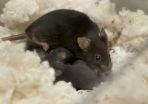(Press-News.org) For the last decade, astronomers have observed curious "hotspots" on Saturn's poles. In 2008, NASA's Cassini spacecraft beamed back close-up images of these hotspots, revealing them to be immense cyclones, each as wide as the Earth. Scientists estimate that Saturn's cyclones may whip up 300 mph winds, and likely have been churning for years.
While cyclones on Earth are fueled by the heat and moisture of the oceans, no such bodies of water exist on Saturn. What, then, could be causing such powerful, long-lasting storms?
In a paper published today in the journal Nature Geoscience, atmospheric scientists at MIT propose a possible mechanism for Saturn's polar cyclones: Over time, small, short-lived thunderstorms across the planet may build up angular momentum, or spin, within the atmosphere -- ultimately stirring up a massive and long-lasting vortex at the poles.
The researchers developed a simple model of Saturn's atmosphere, and simulated the effect of multiple small thunderstorms forming across the planet over time. Eventually, they observed that each thunderstorm essentially pulls air towards the poles -- and together, these many small, isolated thunderstorms can accumulate enough atmospheric energy at the poles to generate a much larger and long-lived cyclone.
The team found that whether a cyclone develops depends on two parameters: the size of the planet relative to the size of an average thunderstorm on it, and how much storm-induced energy is in its atmosphere. Given these two parameters, the researchers predicted that Neptune, which bears similar polar hotspots, should generate transient polar cyclones that come and go, while Jupiter should have none.
Morgan O'Neill, the paper's lead author and a former PhD student in MIT's Department of Earth, Atmospheric and Planetary Sciences (EAPS), says the team's model may eventually be used to gauge atmospheric conditions on planets outside the solar system. For instance, if scientists detect a cyclone-like hotspot on a far-off exoplanet, they may be able to estimate storm activity and general atmospheric conditions across the entire planet.
"Before it was observed, we never considered the possibility of a cyclone on a pole," says O'Neill, who is now a postdoc at the Weizmann Institute of Science in Israel.
"Only recently did Cassini give us this huge wealth of observations that made it possible, and only recently have we had to think about why [polar cyclones] occur."
O'Neill's co-authors are Kerry Emanuel, the Cecil and Ida Green Professor of Earth, Atmospheric and Planetary Sciences, and Glenn Flierl, a professor of oceanography in EAPS.
Beta-drifting toward a cyclone
Polar cyclones on Saturn are a puzzling phenomenon, since the planet, known as a gas giant, lacks an essential ingredient for brewing up such storms: water on its surface.
"There's no surface at all -- it just gets denser as you get deeper," O'Neill says. "If you lack choppy waters or a frictional surface that allows wind to converge, which is how hurricanes form on Earth, how can you possibly get something that looks similar on a gas giant?"
The answer, she found, may be something called "beta drift" -- a phenomenon by which a planet's spin causes small thunderstorms to drift toward the poles. Beta drift drives the motion of hurricanes on Earth, without requiring the presence of water. When a storm forms, it spins in one direction at the surface, and the opposite direction toward the upper atmosphere, creating a "dipole of vorticity." (In fact, videos of hurricanes taken from space actually depict the storm's spin as opposite to what's observed on the ground.)
"The whole atmosphere is kind of being dragged by the planet as the planet rotates, so all this air has some ambient angular momentum," O'Neill explains. "If you converge a bunch of that air at the base of a thunderstorm, you're going to get a small cyclone."
The combination of a planet's rotation and a circulating storm generates secondary features called beta gyres that wrap around a storm and essentially split its dipole in half, tugging the top half toward the equator, and the bottom half toward the pole.
The team developed a model of Saturn's atmosphere and ran hundreds of simulations for hundreds of days each, allowing small thunderstorms to pop up across the planet. The researchers observed that multiple thunderstorms experienced beta drift over time, and eventually accumulated enough atmospheric circulation to create a much larger cyclone at the poles.
"Each of these storms is beta-drifting a little bit before they sputter out and die," O'Neill says. "This mechanism means that little thunderstorms -- fast, abundant, but not very strong thunderstorms -- over a long period of time can actually accumulate so much angular momentum right on the pole, that you get a permanent, wildly strong cyclone."
Next stop: Jupiter
The team also explored conditions in which planets would not form polar cyclones, even though they may experience thunderstorms. The researchers found that whether a polar cyclone forms depends on two parameters: the energy within a planet's atmosphere, or the total intensity of its thunderstorms; and the average size of its thunderstorms, relative to the size of the planet itself. Specifically, the larger an average thunderstorm compared to a planet's size, the more likely a polar cyclone is to develop.
O'Neill applied this relationship to Saturn, Jupiter, and Neptune. In the case of Saturn, the planet's atmospheric conditions and storm activity are within the range that would generate a large polar cyclone. In contrast, Jupiter is unlikely to host any polar cyclones, as the ratio of any storm to its overall size would be extremely small. The dimensions of Neptune suggest that polar cyclones may exist there, albeit on a fleeting basis.
The researchers are eager to see whether their predictions, particularly for Jupiter, bear out. Next summer, NASA's Juno spacecraft is scheduled to enter into an orbit around Jupiter, kicking off a one-year mission to map and explore Jupiter's atmosphere.
"If what we know about Jupiter currently is correct, we predict that we won't see these wildly strong cyclones," O'Neill says. "We'll find out next year if our predictions are true."
INFORMATION:
This research was funded in part by the National Science Foundation.
New research by NOAA, University of Alaska, and Woods Hole Oceanographic Institution in the journal Oceanography shows that surface waters of the Chukchi and Beaufort seas could reach levels of acidity that threaten the ability of animals to build and maintain their shells by 2030, with the Bering Sea reaching this level of acidity by 2044.
"Our research shows that within 15 years, the chemistry of these waters may no longer be saturated with enough calcium carbonate for a number of animals from tiny sea snails to Alaska King crabs to construct and maintain their shells ...
AUSTIN, Texas -- Researchers in the Cockrell School of Engineering at The University of Texas at Austin have developed a groundbreaking new energy-absorbing structure to better withstand blunt and ballistic impact. The technology, called negative stiffness (NS) honeycombs, can be integrated into car bumpers, military and athletic helmets and other protective hardware.
The technology could have major implications for the design and production of future vehicles and military gear to improve safety.
The new NS honeycomb structures are able to provide repeated protection ...
ALEXANDRIA VA, JUNE 15, 2015 - A statistical analysis of poll performance in battleground states over the last three presidential elections shows polling firms produced estimates that were fairly accurate in 2004 and 2008, but underestimated support for President Obama in 2012, a new article reports.
The article's authors--Ole J. Forsberg and Mark E. Payton, professors in the department of statistics at Oklahoma State University--believe the culprit for bad polling in the 2012 election may have roots in "outdated and possibly flawed sampling methodology" that resulted ...
SAN FRANCISCO--For many generations, Bedouin people living in the Abu Dabbab area on the Egyptian Red Sea coast have heard distinct noises--like the rumbling of a quarry blast or cannon shot--accompanying small earthquakes in the region. Now, a new study published in the Bulletin of the Seismological Society of America offers an explanation for this uniquely noisy seismic event.
Seismic activity in the area of the Egyptian seaside resort Abu Dabbab may be caused by an active fault that lays below a 10-kilometer thick block of old, now rigid igneous rock. The surface of ...
(Philadelphia, PA) - It's long been known that scratching evokes a rewarding and pleasurable sensation in patients with chronic itch. Now, researchers in the Department of Dermatology and Temple Itch Center at Temple University School of Medicine (TUSM) may be closer to understanding why.
Using advanced fMRI imaging, the researchers looked at activity in the brain while 10 chronic itch patients and 10 healthy subjects scratched an itch. They found that areas of the brain involved in motor control and reward processing were more activated in chronic itch patients while ...
There is little information about bee populations in Alaska, where native bee pollination is critical to the maintenance of subarctic ecosystems. A team from the University of Alaska Fairbanks and the USDA have now completed a two-year study on bumble bees in agricultural areas in the region. The research was published in the Biodiversity Data Journal.
Pollination is one of the most fundamental processes sustaining agricultural production and natural ecosystems. While decrease in bee populations is a common concern, most press coverage has been directed towards Colony ...
Recent genomic research has prompted a petition that calls for the reclassification of African elephants from one threatened species to two endangered species to protect both from imminent extinction.
The U.S. Fish and Wildlife Service (FSW) has 90 days to respond to a petition from the Center for Biological Diversity at http://www.biologicaldiversity.org, a public interest environmental organization dedicated to the protection of native species and their habitats. The Center requests that the FWS recognize the forest elephant (Loxodonta cyclotis) and savannah elephant ...
A strain of bacteria that "breathes" uranium may hold the key to cleaning up polluted groundwater at sites where uranium ore was processed to make nuclear weapons.
A team of Rutgers University scientists and collaborators discovered the bacteria in soil at an old uranium ore mill in Rifle, Colorado, almost 200 miles west of Denver. The site is one of nine such mills in Colorado used during the heyday of nuclear weapons production.
The research is part of a U.S. Department of Energy program to see if microorganisms can lock up uranium that leached into the soil years ...
Zinc plays an important role in a woman's ability to successfully breast-feed her child, according to health researchers.
It has long been known that zinc, an essential trace element, is passed to infants through mother's breast milk. The levels of zinc in mother's milk and the effects of zinc deficiency in infants have been previously studied, but the role of zinc in breast development and function in lactating mothers is a relatively new area of research.
The protein ZnT2 transports zinc in specific tissues in the body, including the mammary glands. Shannon L. Kelleher ...
This news release is available in German. ETH material engineers found that the performance of ion-conducting ceramic membranes that are so important in industry depends largely on their strain and buckling profiles. For the first time, scientists can now selectively manipulate the buckling profile, and thus the physical properties, allowing new technical applications of these membranes.
"Ionics, ion-based data processing and energy conversion, is the electronics of the future", says Jennifer Rupp, a professor of Electrochemical Materials at ETH Zurich, and therewith ...



